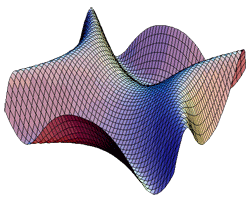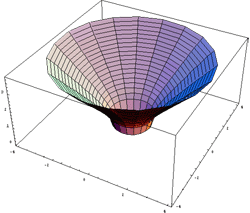18.01A Topics:
- Review of basic ideas of Differential Calculus. (Chaps. 2-7, Appendix)
- Applications of Integration: area, volume, volume of solids of revolution, arclength, area of a surface of revolution, work and energy, hydrostatic force. (Chap. 7)
- Techniques of integration: substitution, trigonometric integrals, trigonometric substitutions, partial fractions, integration by parts, miscellaneous methods, numerical integration and Simpson's Rule. (Chap. 10)
- Further Applications of Integration: Center of mass, centroids, moment of inertia. (Chap. 11)
- Indeterminate forms, L'Hôpital's Rule, improper integrals.
- Sequences, infinite series, convergent vs. divergent series, comparison tests, integral test, ratio and root tests, alternating series, absolute vs. conditional convergence. (Chap. 13)
- Power series, interval of convergence, differentiation and integration of power series, Taylor Series and Taylor's Formula, applications to differential equations. (Chap. 14)
- Polar coordinates and polar graphs. (Chap. 16)
- Applications of integration to probability and statistics may be covered as time permits.
18.02A Topics:
- Coordinates, vectors and vector algebra in R2 and R3; dot product, cross product, projection, equations of lines and planes, matrix methods. (Chaps. 17-18 and Notes)
- Parametric equations of curves in R2 and R3; coordinates, derivatives of vector-valued functions, velocity and acceleration, tangent vectors, arclength; curvature and unit normal vector, tangential and normal components of acceleration, Kepler's Laws and Newton's Law of Gravitation. (Chaps. 17-18)
- Cylinders and surfaces of revolution, cylindrical and spherical coordinates; parameterized surfaces in R2 and R3. (Chap. 18)
- Functions of several variables - limits, continuity, and differentiabilty; partial derivatives, gradients, linear approximation, directional derivatives, Chain Rule. (Chap. 19)
- Optimization - unconstrained and constrained; implicit functions and implicit differentiation. (Chap. 19)
- Multiple integrals, integration over regions in R2 and R3 and their applications using Cartesian, polar, cylindrical, and
spherical coordinates, gravitational attraction. (Chap. 20)
- Vector fields and their applications. (Notes)
- Integration over curves in R2 and R3 by parameterization; work integrals, and applications; independence of path and conservative vector fields; Green's Theorem. (Chap. 21)
- Integration over surfaces in R3 by parameterization - flux integrals, surface area, and applications. (Chap. 21)
- Calculus of vector fields; curl and divergence of vector fields; Stokes’ Theorem, Divergence Theorem; Maxwell's equations. (Chap. 21)
|
 This sequence, intended for students who have had a full year of high school calculus, begins with 18.01A, a six-week review of one-variable calculus, emphasizing integration techniques and applications, polar coordinates, improper integrals, and infinite series. Prerequisite is a score of 4 or 5 on the Advanced Placement Calculus AB exam or a passing grade on the first half of the 18.01 Advanced Standing Exam, covering differentiation and elementary integration. Most students completing 18.01A continue directly into 18.02A, in which the remaining weeks of the fall term is devoted to the material in the first half of Calculus II. 18.02A is taught at the same pace as 18.02. Concourse students complete the second half of Calculus II during Independent Activities Period (IAP) in January.
This sequence, intended for students who have had a full year of high school calculus, begins with 18.01A, a six-week review of one-variable calculus, emphasizing integration techniques and applications, polar coordinates, improper integrals, and infinite series. Prerequisite is a score of 4 or 5 on the Advanced Placement Calculus AB exam or a passing grade on the first half of the 18.01 Advanced Standing Exam, covering differentiation and elementary integration. Most students completing 18.01A continue directly into 18.02A, in which the remaining weeks of the fall term is devoted to the material in the first half of Calculus II. 18.02A is taught at the same pace as 18.02. Concourse students complete the second half of Calculus II during Independent Activities Period (IAP) in January. Website:
Website: